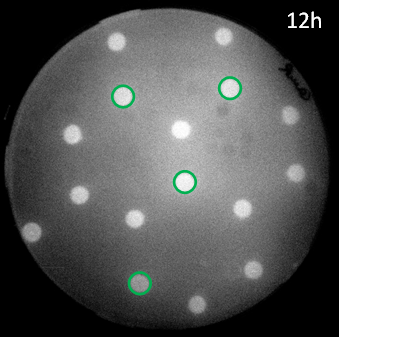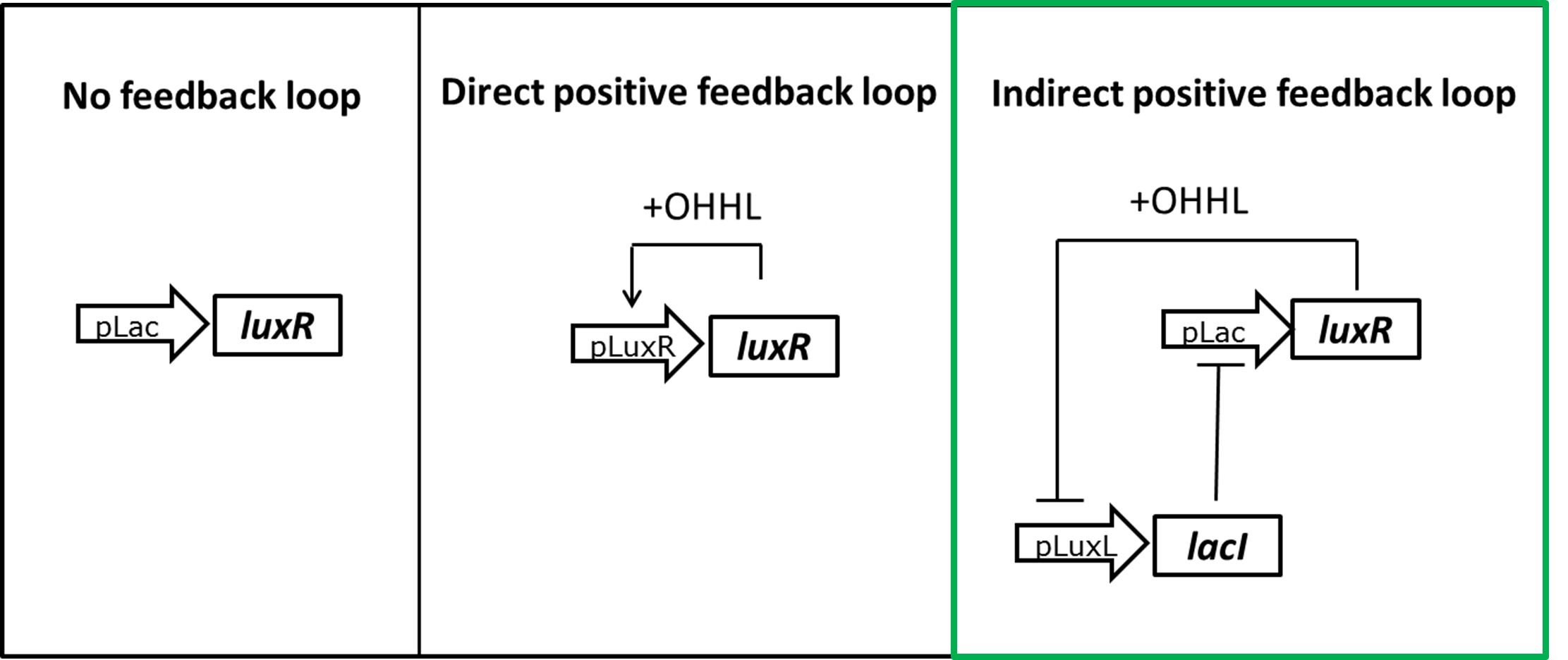Team:ETH Zurich/Experiments 6
From 2013.igem.org
Contents |
GFP diffusion tests with sender cells and wild-type pLux receiver constructs
Diffusion experiments were performed to study OHHL diffusion from the sender colonies to the receiver colonies. The colonies were placed in a hexagonal grid pattern such that every colony can have either zero, one, two or three mine colonies adjacent to it. Depending on the number of mines around a non-mine colony, more OHHL will be processed in the receiver colonies due to the higher number of mines. 1.5μl of the receiver and sender cultures were plated according to a hexagonal grid pattern on an agar plate. We then investigated the diffusion patterns by scanning the plate with a molecular imaging system. Images of the GFP fluorescence were taken at time intervals of 1.5hours after the first detection of fluorescence. Images taken after 11 hours showed GFP saturation.
The picture on the left shows the scanned image of GFP fluorescence after 11 hours of incubation. The green circles mark the mine colonies. The receiver colonies are those that process the OHHL that diffused from the sender colonies. The difference in fluorescence in the receiver colonies correlates directly to the number of adjacent mine colonies. The data from this experiment shows almost complete agreement with the spatio-temporal model.
The graph on the right shows the relative intensity of the GFP signal in the receiver colonies with one, two and three adjacent mine colonies at different timepoints. All scanned images of the plate similar to the one depicted above were analyzed using the image processing program ImageJ. The GFP fluorescence reaches saturation after 11 hours of incubation at 37 ℃ . Due to the presence of more mine colonies, more OHHL molecules are processed by the non-mine and higher fluorescence can be observed. Three adjacent mines lead to the highest value of fluorescence compared to two or one adjacent mine colonies. This data is qualitatively similar to the model, but GFP expression is quantitatively different in comparison to the model.
GFP diffusion tests with sender cells and mutated pluxR promoter receiver constructs
Also the mutant promoter [http://parts.igem.org/Part:BBa_K1216007 BBa_K1216007] we obtained through site-saturation mutagenesis was tested in the hexagonal grid experiment with LuxI sender cells. The sensitivity for OHHL was very low and only in the case where three mines surround a receiver colony some fluorescence could be observed. Still the results are consistent with the model predictions and led to the rational design of additional promoter mutants, where either one of the two point mutions was changed back with the goal to recover some of the sensitivity of the wild type.
Optimization of LuxR production regulation to reduce basal reporter activation
The GFP reporter system shows significant leakiness in the absence of OHHL. To pinpoint the source of this basal activation we tested the GFP expression of different constructs in liquid culture over time (Figure 6). We defined the background using a construct without GFP (Figure 5, top left). We used a simple pLuxR-GFP construct without LuxR protein (Figure 5, top right) to measure the basal expression resulting from promoter leakiness alone. The measured signal is comparable to background levels, suggesting that pLuxR promoter per se is remarkably tight.
The complete pLac-Lux-pLuxR-GFP receiver construct (Figure 5, bottom left) in the absence of OHHL induction shows a jump in the measured GFP levels. This results suggest that most of the leakiness comes from an activation of the pLux promoter through LuxR alone, meaning in the absence of the OHHL inducer (Figure 3).
Addition of OHHL (Figure 5, bottom right) determines a steep 5-7 times GFP induction. Reduction of the LuxR dependent basal activation could significantly improve the On/Off Ratio.
Hydrolase reporters are enzymatic systems. Multiple rounds of catalysis provide intrinsic signal amplification when compared to GFP. Therefore we expect a very high sensitivity to basal expression. Moderate hydrolase expression level could already result in total substrate conversion and signal saturation. Since our model anticipates the potential problem we designed different strategies to reduce the level of LuxR in the uninduced state (Figure 7).
The overall idea was to replace a constitutive LuxR expression with an OHHL dependent induction. In a self-regulation motif only a residual amount of LuxR is present in the non induced state, minimizing its interaction with the promoter. Upon induction the protein sustain its own production allowing for a full activation of the system. To achieve autoregulation one possibility is to use a direct positive feedback loop in which the luxR gene is placed under it's own pLuxR promoter. Only upon induction with OHHL LuxR would be produced. As an alternative we could use LacI expression to inhibit LuxR production in the uninduced state. By placing the lacI gene under a negatively LuxR/OHHL regulated promoter (pLuxL) an indirect positive autoregulation for LuxR expression is obtained.
 "
"












